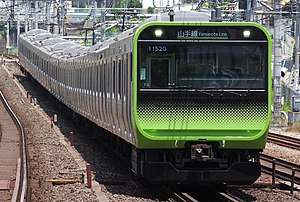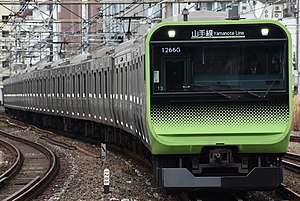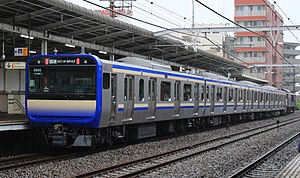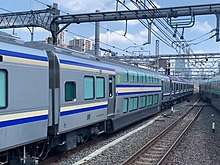E235 series
The E235 series (E235系, E235-kei) is a DC electric multiple unit (EMU) commuter train type operated by East Japan Railway Company (JR East) on Yamanote Line services in Tokyo, Japan since 2015 and will soon be on the Sobu Rapid and Yokosuka lines by 2021.
| E235 series | |
|---|---|
 An E235-0 series train on the Yamanote Line in 2018 | |
| Manufacturer | J-TREC |
| Built at | Niitsu, Yokohama |
| Replaced | E217 series, E231-500 series |
| Constructed | 2015–present |
| Entered service | 30 November 2015 |
| Number under construction | 709 vehicles |
| Number built | 586 vehicles (as of 10 August 2020) |
| Number in service | 550 vehicles (50 sets) |
| Formation | 11/4 cars per trainset |
| Operator(s) | JR East |
| Depot(s) | Tokyo General Rolling Stock Centre |
| Line(s) served | Yamanote Line Future: Sōbu Line (Rapid), Yokosuka Line |
| Specifications | |
| Car body construction | Stainless steel |
| Car length | 20,000 mm (65 ft 7 in) (including couplers) 19,570 mm (64 ft 2 in) (end cars) 19,500 mm (64 ft 0 in) (intermediate cars) |
| Width | 2,950 mm (9 ft 8 in) |
| Height | 3,620 mm (11 ft 11 in) |
| Floor height | 1,130 mm (3 ft 8 in) |
| Doors | 4 pairs per side 2 doors per side (Green cars) |
| Maximum speed | 120 km/h (75 mph) |
| Traction system | Variable frequency (SiC-MOSFET) |
| Acceleration | 3.0 km/(h⋅s) (1.9 mph/s) |
| Deceleration | 4.2 km/(h⋅s) (2.6 mph/s) |
| Electric system(s) | 1,500 V DC catenary |
| Current collection method | Pantograph |
| Bogies | DT80, TR255, TR264 |
| Safety system(s) | ATS-P, D-ATC |
| Track gauge | 1,067 mm (3 ft 6 in) |
Design features
The E235 series design was developed from the earlier E233 series trains, and like the E233 and E231 series trains, the new E235 series trains have stainless steel bodies.[1] The exterior styling was overseen by the industrial design firm Ken Okuyama Design.[2] Baggage racks and hand-holds have been lowered 5 cm for easier access and the seats are 1 cm wider than previous trains. The car interiors also have up to 36 digital monitors for various informational displays. The window behind the drivers cab has been lowered so children can get a better view of the operator of the cars. The temperature of each car is also monitored; the system can predict the number of passengers at upcoming stations and adjust the temperature for passenger comfort. This information is also communicated to a smart phone application, allowing customers to choose in which car to ride based on their temperature preference.[3]
 A DT80 motor bogie
A DT80 motor bogie LCD advertising screens
LCD advertising screens
Variants

Future operations

History
Details of the E235 series design were first announced in July 2014.[4] The first, pre-series set 01, train was delivered from the J-TREC factory at Niitsu in March 2015,[5] with test-running commencing on the Yamanote Line on 30 March.[6]
Set number 01 entered revenue service on 30 November 2015, with a departure ceremony at Osaki Station, but was taken out of service later the same day following faults with door-close indicators and problems stopping at the correct position along the station platform.[7] Test running on the Yamanote Line resumed from 27 December.[8] The train returned to revenue service on the Yamanote Line on 7 March 2016.[9]
In June 2016, JR East announced its official plans for the introduction of a fleet of 49 full-production sets (539 vehicles) between spring 2017 and spring 2020.[10] Most units will be built as 10-car sets and use converted former E231-500 series SaHa E231-4600 cars, while two units will be built as 11-car sets.[10] The first full-production standard set, 02, was delivered from the J-TREC factory in Niitsu in April 2017.[11] This entered service on 22 May 2017.[12]
In April 2018, JR East announced the replacement of the existing E217 series on the Sōbu Line (Rapid) and Yokosuka Line by new E235 series trains beginning in fiscal 2020. The fleet will consist of 51 11-car trains and 46 four-car trains, for a total of 745 cars to be newly constructed.
E235-0 series
| E235-0 series | |
|---|---|
 Yamanote Line 11-car E235-0 series set 13 in January 2020 | |
| Replaced | E231-500 series |
| Constructed | 2015–2019 |
| Entered service | 20 November 2015 |
| Number built | 550 vehicles[Note 1] |
| Number in service | 550 vehicles (50 sets) |
| Formation | 11 cars per trainset |
| Fleet numbers | 01–50 |
| Capacity | 1724 passengers |
| Operator(s) | JR East |
| Depot(s) | Tokyo |
| Line(s) served | Yamanote Line |
| Specifications | |
| Car body construction | Stainless steel |
| Width | 2,950 mm (9 ft 8 in) |
| Doors | 4 pairs per side |
| Electric system(s) | 1,500 V DC overhead catenary |
| Track gauge | 1,067 mm (3 ft 6 in) |
| Notes | |
| |
A total of 50 11-car trains were delivered for use on the Yamanote Line, replacing the E231-500 series in use since 2002.[14] A pre-series train was delivered in March 2015, first entering revenue service from 30 November 2015, but then taken out of service for three months before re-entering service in March 2016.
The pre-series set (01) was converted to the full production standard by 14 March 2018.[15]
Formations
As of 1 January 2020, 50 11-car sets (01–50) are based at Tokyo General Rolling Stock Centre and formed with six motored ("M") cars and five non-powered trailer ("T") cars.[15] All but two sets have SaHa E235-4600 cars (Car 10), which are modified from former E231-500 series SaHa E231-4600 cars.[15]
← Counterclockwise (Inner) Clockwise (Outer) → | |||||||||||
| Car No. | 11 | 10 | 9 | 8 | 7 | 6 | 5 | 4 | 3 | 2 | 1 |
|---|---|---|---|---|---|---|---|---|---|---|---|
| Designation | Tc | T | M1 | M2 | T' | M1 | M2 | T | M1 | M2 | Tc' |
| Numbering (Sets 01–03, 06–50) | KuHa E235 | SaHa E235-4600 | MoHa E235 | MoHa E234 | SaHa E234 | MoHa E235 | MoHa E234 | SaHa E235 | MoHa E235 | MoHa E234 | KuHa E234 |
| Numbering (Sets 04–05) | SaHa E235-500 | ||||||||||
| Capacity (total/seated) | 142/39 | 160/48 | 160/51 | 160/51 | 160/51 | 160/51 | 160/51 | 160/51 | 160/51 | 160/51 | 142/39 |
- On the pre-series set (01), car 3 has one PS33D single-arm pantograph, car 6 has PS33H and PS36A single-arm pantographs (one used as a backup), and car 9 has one PS33H single-arm pantograph.[1]
- On the remaining production sets (02-50), cars 3 and 9 each have one PS33H single-arm pantograph and car 6 has two PS33H single-arm pantographs (one used as a backup).[16]
- All cars have an accessible/priority "free space".[15]
- Car 4 is designated as a mildly air-conditioned car.[15]
Exterior
 KuHa E234-1 (Car 1)
KuHa E234-1 (Car 1) MoHa E234-3 (Car 2)
MoHa E234-3 (Car 2) MoHa E235-3 (Car 3)
MoHa E235-3 (Car 3) SaHa E235-1 (Car 4)
SaHa E235-1 (Car 4) MoHa E234-2 (Car 5)
MoHa E234-2 (Car 5) MoHa E235-2 (Car 6)
MoHa E235-2 (Car 6) SaHa E234-1 (Car 7)
SaHa E234-1 (Car 7) MoHa E234-1 (Car 8)
MoHa E234-1 (Car 8) MoHa E235-1 (Car 9)
MoHa E235-1 (Car 9) SaHa E235-4620 (Car 10)
SaHa E235-4620 (Car 10) KuHa E235-1 (Car 11)
KuHa E235-1 (Car 11)
Interior
Passenger accommodation consists of longitudinal bench seating throughout, with an individual seat width of 460 mm (18.1 in) per person, compared to 450 mm (17.7 in) for the earlier E231-500 series.[1] Priority seating is provided at both ends of each car (except in end cars), and a space for wheelchairs or strollers is provided at one end of each car.[1] LED lighting is used throughout.[1] The initial plan was for paper advertisements inside the cars to be completely abolished, replaced by 18 LCD colour advertising screens in each car,[1] but following feedback from advertising companies and users, the first train to enter service will include traditional paper advertisements in addition to the LCD screens.[17]
The full-production sets (02 onward) incorporate a number of design changes. Whereas in the pre-series set 01, the luggage rack height was generally 1,678 mm (5 ft 6.1 in) with a height of 1,628 mm (5 ft 4.1 in) in the end cars and in priority seating areas, this is standardized as 1,628 mm throughout from set 02 onward.[12] The handrails next to seats in the full-production sets have an embossed surface compared with the polished metal surface used in the pre-series set.[12]
 7-person bench seating in car SaHa E235-4620 (former SaHa E231-4600 car)
7-person bench seating in car SaHa E235-4620 (former SaHa E231-4600 car) Priority seating
Priority seating The interior of a full-production SaHa E235 car in August 2017
The interior of a full-production SaHa E235 car in August 2017
E235-1000 series
| E235-1000 series | |
|---|---|
 E235-1000 series set J-01 | |
| Replaced | E217 series |
| Constructed | 2020–present |
| Entered service | 2020 (planned) |
| Number under construction | 709 vehicles |
| Number built | 36 vehicles (as of 10 August 2020)[18] |
| Formation | 11/4 cars per trainset |
| Fleet numbers | F-01–, J-01– |
| Operator(s) | JR East |
| Depot(s) | Kamakura |
| Line(s) served | Kashima Line, Narita Line, Sotobō Line, Sōbu Line (Rapid), Sōbu Main Line, Uchibō Line, Yokosuka Line |
| Specifications | |
| Car body construction | Stainless steel |
| Width | 2,950 mm (9 ft 8 in) |
| Doors | 4 pairs per side 2 doors per side (Green cars) |
| Electric system(s) | 1,500 V DC overhead catenary |
| Track gauge | 1,067 mm (3 ft 6 in) |
A total of 745 cars (consisting of 51 11-car trains and 46 four-car trains) will be built for use on the Sōbu Line (Rapid) and Yokosuka Line, replacing the E217 series in use since 1994.
On 21 April 2020, the Green cars of the first set were completed at the J-TREC factory in Yokohama and transported to the J-TREC factory in Niitsu to be joined with standard cars.[19] On 3 June 2020, the first 11-car set was completed at Niitsu;[20] it was delivered to Kamakura Depot on 8 June 2020.[21] The first 4-car set was completed at Niitsu on 16 June 2020[22] and was delivered on 19 June 2020.[23].
Formations
11-car sets
As of 8 July 2020, two 11-car sets (F-01–F-02) are based at Kamakura Depot and formed with six motored ("M") cars and five non-powered trailer ("T") cars.[18]
← Kimitsu, Narita Airport Kurihama → | |||||||||||
| Car No. | 11 | 10 | 9 | 8 | 7 | 6 | 5 | 4 | 3 | 2 | 1 |
|---|---|---|---|---|---|---|---|---|---|---|---|
| Designation | Tc | M1 | M2 | T | M1 | M2 | Tsd | Tsd' | M1 | M2 | Tc' |
| Numbering | KuHa E235-1000 | MoHa E235-1000 | MoHa E234-1000 | SaHa E235-1000 | MoHa E235-1200 | MoHa E234-1200 | SaRo E235-1000 | SaRo E234-1000 | MoHa E235-1300 | MoHa E234-1300 | KuHa E234-1000 |
- Cars 7 and 10 each have one single-arm pantograph and car 3 has two single-arm pantographs (one used as a backup).
- Cars 1-3 and 6-11 have an accessible/priority "free space".
- Cars 1, 5, and 6 each have a toilet (universal design in cars 1 and 6).
- Car 8 is designated as a mildly air-conditioned car.
- Cars 4 and 5 are bilevel Green Cars.
4-car sets
As of 1 July 2020, two four-car sets (J-01–J-02) are based at Kamakura Depot and formed with two motored ("M") cars and two non-powered trailer ("T") cars.[18]
← Kimitsu Kurihama → | ||||
| Car No. | +4 | +3 | +2 | +1 |
|---|---|---|---|---|
| Designation | Tc | M1 | M2 | Tc' |
| Numbering | KuHa E235-1100 | MoHa E235-1100 | MoHa E234-1100 | KuHa E234-1100 |
- Car +3 has two single-arm pantographs (one used as a backup).
- All cars have an accessible/priority "free space".
- Car +1 has a universal design toilet.
Interior

As with their counterparts on the Yamanote Line, passenger accommodation on ordinary cars consists of longitudinal bench seating throughout.[24] A space for wheelchairs or strollers is provided at one end of each car, except on Green cars. The seats will be 10 mm (0.4 in) as seen the wider than those seen in earlier E217 series cars. The information screens measure 21 inches, and display information in four different languages (Japanese, English, Chinese and Korean). LED lighting is used throughout. Surveillance cameras are also equipped in order to increase safety. Green cars are equipped with a power outlet under the armrests as well as Wi-Fi.
References
- Mizutani, Keisuke (July 2015). E235系一般形直流電車 [E235 series general-purpose DC EMU]. Japan Railfan Magazine (in Japanese). Vol. 55 no. 651. Japan: Koyusha Co., Ltd. pp. 92–100.
- "news 2014.07.03" (in Japanese). Japan: Ken Okuyama Design. 3 July 2014. Retrieved 4 July 2014.
- Japan Railway Journal (episode 9). NHK. 2015. Event occurs at 8:58.
- Saito, Masatoshi (2 July 2014). JR東:山手線に新型電車「E235系」 来秋から導入 [JR East to introduced new E235 series trains on Yamanote Line from next autumn]. Mainichi Shimbun (in Japanese). Japan: The Mainichi Newspapers. Archived from the original on 2 January 2015. Retrieved 8 June 2016.
- E235系量産先行車配給輸送 [E235 series pre-series set delivered]. RM News (in Japanese). Japan: Neko Publishing Co., Ltd. 26 March 2015. Archived from the original on 2 April 2015. Retrieved 8 June 2016.
- E235系が山手線で試運転 [E235 series test run on Yamanote Line]. Japan Railfan Magazine Online (in Japanese). Japan: Koyusha Co., Ltd. 31 March 2015. Retrieved 31 March 2015.
- 山手線に次世代通勤電車 E235系トラブル相次ぐ [Problems with E235 series "next-generation commuter train" on Yamanote Line]. Sponichi Annex (in Japanese). Japan: Sports Nippon Newspapers. 30 November 2015. Archived from the original on 8 December 2015. Retrieved 8 June 2016.
- E235系が山手線で試運転 [E235 series test run on Yamanote Line]. Japan Railfan Magazine Online (in Japanese). Japan: Koyusha Co., Ltd. 8 January 2016. Retrieved 8 January 2016.
- 山手線 新型車両が3か月ぶりに運転再開 [New Yamanote Line train re-enters service after 3 months]. NHK News Web (in Japanese). Japan: NHK. 7 March 2016. Archived from the original on 8 March 2016. Retrieved 7 March 2016.
- 山手線,2020年春ごろまでにE235系量産車539両を導入 [539 E235 series full-production series cars to be introduced on Yamanote Line by around spring 2020]. Japan Railfan Magazine Online (in Japanese). Japan: Koyusha Co., Ltd. 8 June 2016. Archived from the original on 8 June 2016. Retrieved 8 June 2016.
- E235系02編成 配給輸送 [E235 series set 02 delivered]. Tetsudo Hobidas (in Japanese). Japan: Neko Publishing. 18 April 2017. Archived from the original on 18 April 2017. Retrieved 18 April 2017.
- Kosano, Kagetoshi (23 May 2017). 山手線新型「E235系」量産車は何が違うのか [How do the new Yamanote Line E235 series full-production trains differ?]. Toyo Keizai Online (in Japanese). Japan: Toyo Keizai Inc. Archived from the original on 27 May 2017. Retrieved 27 May 2017.
- "JR東日本,E235系量産先行車を新造" [JR East to build new E235 series prototype train]. Japan Railfan Magazine Online (in Japanese). Japan: Koyusha Co., Ltd. 2 July 2014. Retrieved 2 July 2014.
- JR電車編成表 2019冬 [JR EMU Formations - Winter 2019]. Japan: Kotsu Shimbunsha. 14 November 2018. pp. 49, 62–63, 72, 74–77, 80–81, 96–99. ISBN 978-4-330-93218-7.
- Amanuma, Hideaki (September 2017). E235系量産車 [E235 series full-production trains]. Japan Railfan Magazine (in Japanese). Vol. 57 no. 677. Japan: Koyusha Co., Ltd. pp. 48–50.
- 山手線の新型車両「E235系」、11月30日から運行 中吊り広告は存続 [New Yamanote Line E235 series trains to enter service from 30 November - Paper adverts will be retained]. ITmedia Business Online (in Japanese). Japan: ITmedia Inc. 14 October 2015. Archived from the original on 5 December 2015. Retrieved 8 June 2016.
- "E235系鎌倉車両センター本所編成表(最新版)" [E235 series Kamakura Depot formation list (latest)]. Retrieved 10 August 2020.
- "横須賀・総武快速線の新型E235系グリーン車が完成 横浜から新潟へ、普通車と合流" [Yokosuka / Sobu Rapid Line E235 Green Cars completed, transported from Yokohama to Niitsu for combination with standard cars]. 21 April 2020. Retrieved 22 April 2020.
- "【JR東】E235系1000番台鎌倉車第1編成(F01編成)公式試運転" [[JR East] E235-1000 series Kamakura depot first set (set F01) official test run]. 3 June 2020. Retrieved 3 June 2020.
- "クラF-01編成新津出場" [Kamakura Depot set F-01 delivered from Niitsu Factory]. Retrieved 8 June 2020.
- "【初登場】横須賀・総武快速線用付属編成E235系1000番台クラJ-01編成 出場試運転" [[First Appearance] Yokosuka/Sobu Rapid Line first supplementary E235-1000 set J-01 completion test run]. 16 June 2020.
- "【JR東】E235系1000番代クラJ-01編成 新津出場配給" [[JR East] E235-1000 set J-01 delivered from Niitsu]. 19 June 2020.
- "横須賀・総武快速線用車両の新造について" (PDF). jreast.co.jp (in Japanese). 東日本旅客鉄道. 4 September 2018. Retrieved 3 June 2020.
External links
| Wikimedia Commons has media related to JR East E235. |
- J-TREC press release (in Japanese)